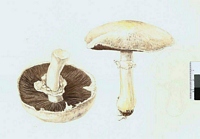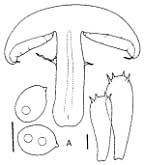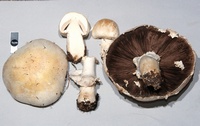|
 Agaricus arvensis Agaricus arvensis
SynonymsPsalliota arvensis
BiostatusPresent in region - Exotic
Images (click to enlarge)
Caption: Watercolour
Owner: G.M. Taylor | 
Caption: A, A. arvensis, Bars = 5 µm. | 
Owner: J.A. Cooper |
Article: Mitchell, A.D.; Walter, M. (1999). Species of Agaricus occurring in New Zealand. New Zealand Journal of Botany 37(4): 715-725 (http://www.rsnz.org/publish/abstracts.php).
Description: Pileus 40-120 mm diam., thick, campanulate
when young, finally convex-applanate, surface silky smooth, white (N9.5) when
young, finally yellow (2.5Y 9/8), yellowing intensified by bruising (2.5Y 9/8
to 5Y 8/10); margin thin, inrolled when young, finally straight, with appendiculate
remnants of veil; lamellae insertion free, thin, crowded, of several lengths,
pale grey when young (5YR 8/2), finally moderate to strong brown (5YR 4/4-3/2);
edge pale and sterile; trama parallel to irregular. Stipe 50-150 x 15-30 mm,
central, solid to fistulose, cylindrical, base round, surface smooth, white
(N9.5) above annulus and with age becoming amber yellow below annulus (5Y 8/8),
yellowing intensified by bruising (5Y 8/10). Annulus descending, cog-wheel-like,
white above with yellowing along the edge, surface silky smooth, white to amber
yellow (N9.5 to 5Y 8/8) below, surface powdery. Flesh white (N9.5), little effect
upon cutting, yellowing upon bruising (5Y 8/ 8); odour of anise; taste sweet.
Schaffer's cross reaction positive.
Basidia 4-spored, 15-30 x 8-10 µm, clavate
with sterigmata 3-5µm. Cheilocystidia 15-40 x 5-10 µm, broadly clavate, hyaline,
abundant. Basidiospores strong brown (5YR 4/4) in mass, size (6.6-)7.1(-7.7)
x (5.3-)6.7(-6.1) µm, elongation (1.1-)1.3(-1.4) µm, ellipsoid, dark brown (5YR
3/2) in water, refractive centre (1-2 droplets), apiculus lateral, germ-pore
not visible.
Habitat: Usually gregarious, sometimes solitary in
lawns or pasture, but also found on bare soil under stone fruit trees.
Distribution: NEW ZEALAND North Otago (Taylor 1983), Canterbury.
Article: Massee, G.E. (1899) [1898]. The fungus flora of New Zealand. Transactions and Proceedings of the New Zealand Institute 31: 282–349 Wellington:.
Description: Pileus bluntly ovate, then expanded and slightly convex, slightly mealy at first, white and
silky, becoming stained pale-yellow when bruised, 10-25 cm. across; flesh thick at the disc,
becoming thin towards the margin, yellowish when cut ; gills free, broadest in front, rather
crowded, whitish, then reddish - brown; spores elliptical, 6 x 4 µ, stem stout, 7-12 cm. high,
rather swollen at the base, almost cylindrical above, white, smooth, even, soft in the centre
and filled with loose fibres; ring pendulous, double, the outer membrane more or less torn.
Habitat: In pastures, &c., often growing in rings.
Distribution: Northern Island, New Zealand. Australia, Tasmania,
South Africa, Ceylon, Europe.
Notes: Closely allied to Agaricus campestris, but known by the pileus becoming yellow when
bruised, and the flesh of pileus and stem not changing to brown when cut. Smell strong and
pleasant. Edible; preferred by many to the mushroom (A. campestris). In large specimens the
pileus is sometimes cracked or scaly, and brownish when old.
|